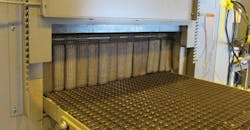The task of engineering a forging operation is more demanding even than the job’s title may indicate. The successful candidate will know metallurgy and material science, details of material deformation, just to cover the basics, and will be familiar with electrical and chemical engineering, along with having a practical familiarity with computer science. In short, to oversee a forging operation one needs to grasp much more than forging.
Perhaps the most practical (if not obvious) example of the parallel knowledge requirements is thermal science, which has influence in all the other engineering disciplines ongoing in a forging operation. Heating is not forging, but forging without heating is not forging at all. For this reason, forging operations make a lot of effort to choose the best thermal technology, meaning not just the most effective but also the most efficient and reliable systems for heating forging billets.
Recently Wisconsin Oven Corp. announced delivery of a natural gas-fired conveyor oven to an aluminum forger, where it will preheat billets for forging. WOC develops various types of conveyor ovens and furnaces, including flat conveyor belt style, chain conveyors, Ferris wheel, carousel, overhead trolley, serpentine, chain-on-edge, spindle, slat type, strip cure, print plate, pusher ovens, dog beams, wash-draw furnaces, and customized continuous conveyor ovens.
Continuous processing ovens may require a higher initial investment, but are typically the most effective design for high-volume industrial processes. For forging, such a design does not require constant loading and unloading or heating up (and cooling down), so it will promote labor- and energy-cost optimization.
The belt conveyor oven shipped recently to the aluminum forging operation is designed to heat 3,000 lbs./hour of aluminum from 70 F to 950°F, as long as the workload is configured so that is able to absorb the heat that is generated within the time available. This specific oven will achieve a maximum temperature of 1,000°F, with guaranteed temperature uniformity of ±10°F at 950°F.
The work chamber of this conveyor oven is 3 ft. 6 in. wide x 25 ft. long x 1 ft. high. As it is to be used in a continuous heating operation it was designed with both top-down and bottom-up airflow, to maximize heating rates and temperature uniformity of the part load configuration. The conveyor system uses a stainless-steel flat-wire belt and a variable-frequency drive provides adjustable speed control.
“This belt conveyor oven utilizes a chain-style curtain to minimize heat spill-out,” according to WOC senior applications engineer Gene Vetter, “which increases operator comfort and reduces wasted energy.”
Among the process features designed into the preheating conveyor are:
• Eurotherm 3204 digital temperature controller, with quick auto-tune function;
• Watlow PM6L digital oven-high-limit controller;
• Honeywell Model 7800 flame-relay with integral purge timer; and
• Allen-Bradley PowerFlex variable-frequency drive, providing adjustable-speed control to the conveyor.
Other design elements include two 24,000 CFM @ 20 HP recirculation blowers (total 48,000 CFM.) Chain style curtains are positioned at each end of the conveyor to reduce heat loss.
Wisconsin Oven conducted full factory testing and adjustment of the belt conveyor oven and prior to shipment ensuring the particular customization details are functional and effective. All safety interlocks were checked for proper operation and to ensure operates properly at the normal and maximum operating temperatures. An extensive quality-assurance checklist was completed, too.
Engineering a forging operation does not require someone with a thorough knowledge of thermal processing technology, but a successful candidate will have to know how to select the most appropriate heating operations.
